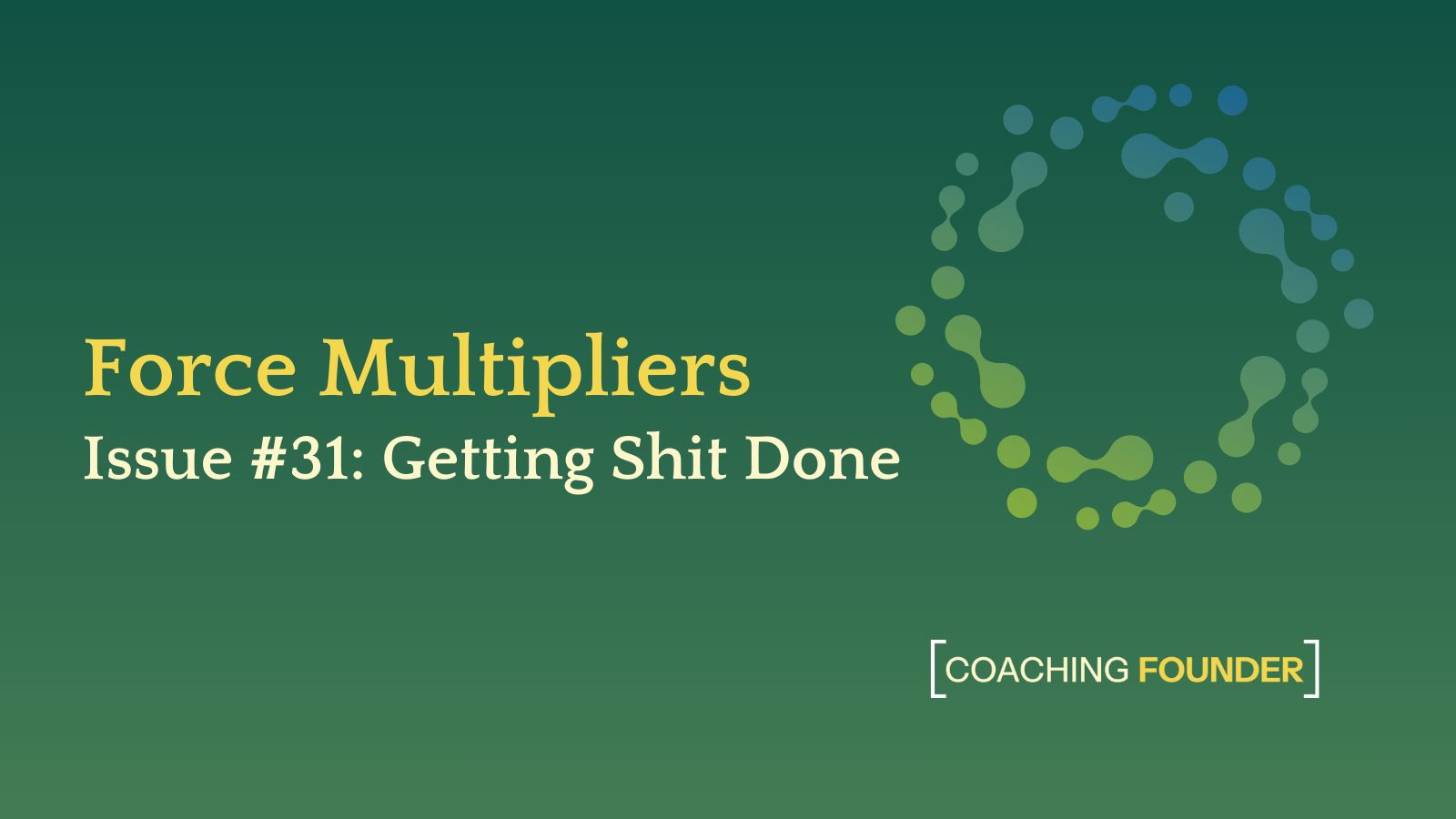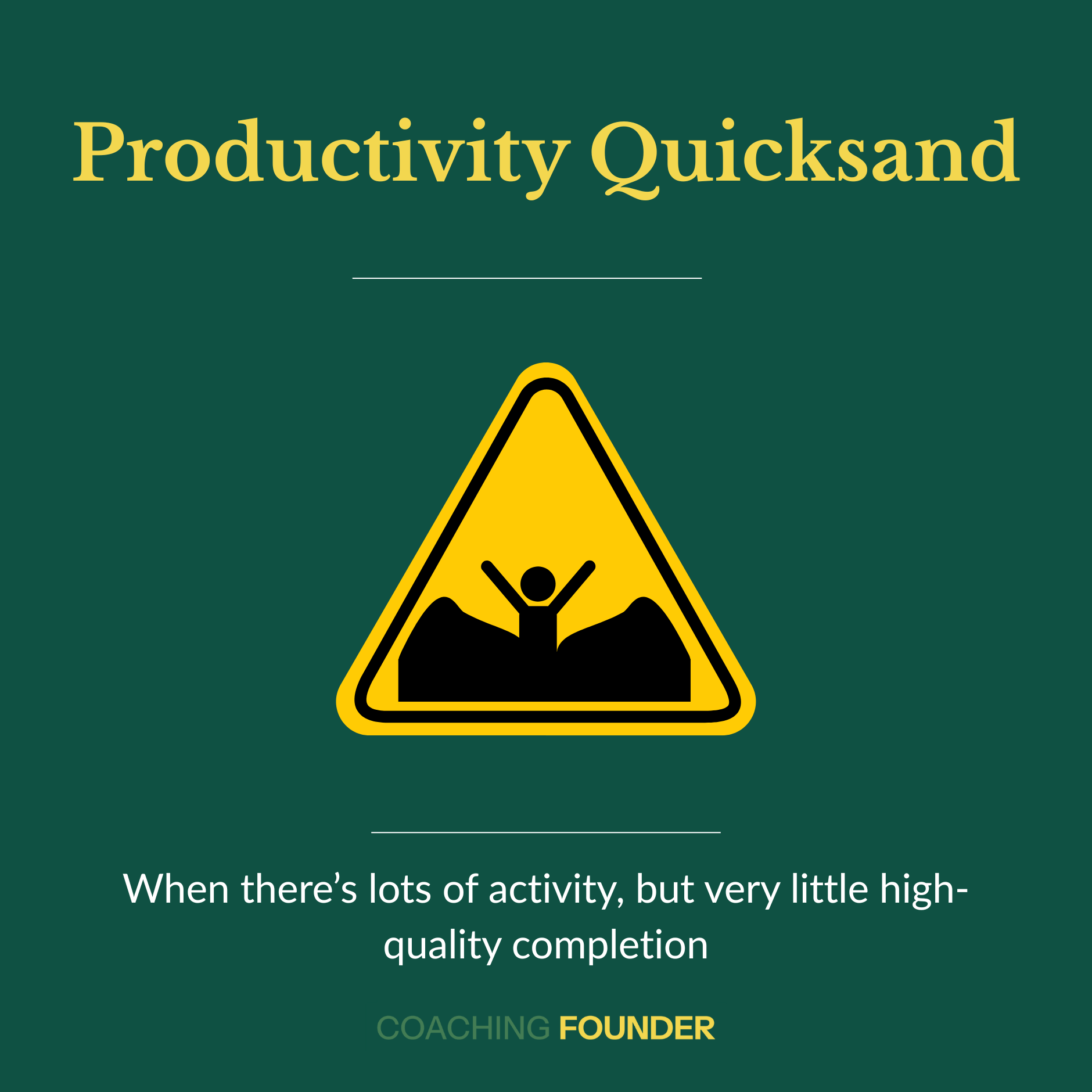- Force Multipliers
- Posts
- On Getting Shit Done
On Getting Shit Done
What to do when your team isn’t doing what they need to do, and how to fix it

Hi! Welcome to another issue of Force Multipliers, your weekly briefing from Regina Gerbeaux, where Silicon Valley's behind-the-scenes operators get battle-tested frameworks for their toughest challenges, from putting out chaotic fires to managing strong personalities.
The Six-Figure Disaster
I recently worked with a company that lost a massive deal. I'm talking six figures with a high-profile client, a household name.
But the money wasn't even the worst part - it was the reputation hit that really stung. They went from being seen as a promising partner to completely unreliable.
What happened?
The CEO trusted his team to build and execute. They promised they would deliver.
But then, the product launch got delayed three times. There were endless excuses about why things weren't going according to plan.
And when they finally shipped, the product had so many bugs that their entire system crashed - not just for the high-profile client, but for ALL their customers. (It actually took the entire system down and crashed for everyone.)
It was a disaster.
When they did a postmortem, the real problem surfaced: their hyperproductivity was actually getting nothing done well.
People were spread too thin. They were stressed. And they felt guilty: on one hand, they were tired, but on the other, every single person understood the sacrifice it took to build a meaningful, massively successful company. Every single one of them wanted the company to win, and didn’t want to slow down.
If you're an operator reading this and thinking, "Oh shit, that could be us," you're not alone. I see this pattern everywhere - teams that are "busy" but not effective, leaders who think movement equals progress, and operators caught in the middle trying to keep everything from falling apart.
You're dealing with what I call productivity quicksand. Productivity quicksand is when there’s lots of activity, but very little high-quality completion. And here's the thing: it's not because your team is lazy or incompetent. It's because you haven't set up the right systems to make getting shit done the path of least resistance.

Let's talk about why your team isn't getting shit done, and what you can actually do about it.
Most teams fail at execution for four predictable reasons.
They're spread too thin - No singular focus means everyone's scattered across multiple projects when they should be laser-focused
No real ownership - Someone might be "responsible" but they're also managing five other things
No operational rhythm - Code gets shipped without testing, deadlines are aspirational, and "checking in" means hoping for the best
Fear-based reporting - People say "it's on track" when it's clearly not because they're afraid of disappointing leadership
The solution isn't more meetings or tighter deadlines. It's creating a system where honesty is rewarded and progress is visible to everyone.
Here’s my playbook on getting your team to execute at an exquisitely high level. Here’s the playbook on getting shit done.
This edition of Force Multipliers is sponsored by Angel Squad!

I’m part of the 2,000+ investors learning to find outliers in early-stage startups. Get access to Hustle Fund's curated deal pipeline, weekly educational sessions, and a global community of angel investors. I’ve loved being a part of Angel Squad so much, I paid for a lifetime membership.
Force Multipliers readers get to try out Angel Squad free for 30 DAYS - use this link to access it now. Big thanks to Angel Squad for sponsoring this newsletter!
The Operator’s Playbook on Getting Shit Done
Step 1: Force Focus Through Brutal Prioritization
The CEO from my disaster story learned this the hard way. But here's a counterexample that worked:
Another CEO I know turned down millions in revenue because he knew his team couldn't execute to the level those customers needed. Initially, he was afraid the customers would go to competitors.
They didn't.
Instead, they waited for his team to be ready because of the integrity he led with. They knew competitors would overpromise and underdeliver, but this CEO's team would actually deliver what they promised.
👉 Your action: List everything your team is working on right now. Cut it by 70%. I'm serious. Pick 2-3 things that absolutely must happen this quarter and pause everything else.
"We're going to do fewer things, but we're going to do them exceptionally well."
Step 2: Create Psychological Safety for Truth-Telling
Remember in the example above, how people said "it's on track" out of fear? That CEO had to shift from leading with fear to leading with reality.
Here's what he did: He had everyone on his leadership team tell him something they didn't want him to know. Then he demonstrated he could receive that information without getting angry. He did this by making them feel heard.
This slowly built trust over time.
👉 Your action: In your next leadership meeting, ask this question: "What's one thing happening in your area that you're worried about but haven't told me yet?"
Then - and this is critical - thank them for sharing it instead of immediately trying to fix it or getting frustrated. You're training people that honesty gets rewarded, not punished."We're going to do fewer things, but we're going to do them exceptionally well."
Step 3: Install Real Operational Checks
The disaster company had no checks and balances. Code got shipped without testing. Deadlines were made up. "Project management" meant hoping really hard that things would work out.
👉 Your action: Implement three non-negotiable checkpoints:
Weekly reality checks: Every Friday, each project owner shares what's actually done (not "almost done" or "90% complete")
Red flag protocols: Anyone can call a meeting if they see something going sideways - no permission needed
Definition of done: Before any project starts, write down exactly what "finished" looks like
💡 Regina’s tip: I have two write-ups that can help you with these steps: my Weekly Memo Template and Definition of Done. Check them out below:
Step 4: Delegate with Actual Authority
The original CEO was micromanaging from a place of anxiety. He'd assign tasks but then hover and second-guess every decision. This created a team that waited for permission instead of taking ownership.
The fix? He learned to show up as a mentor who was ready to problem-solve, not a boss grilling people for answers every week.
👉 Your action: For each major project, assign a single DRI (Directly Responsible Individual) and give them real decision-making authority. Then commit to checking in weekly, not daily.
Step 5: Implement a Master Task Board
Here's where the magic happens. You need a single source of truth for everything that's happening.
Most project management tools fail because they're either too complicated or they don't create the right visibility. My Master Task Board template solves this by:
Making all tasks visible to everyone who needs to see them
Forcing honest conversations about what's actually happening vs. what people say is happening
Creating clear ownership so nothing falls through the cracks
Using the Four Quadrants from Seven Habits to prioritize by importance and urgency
How it works:
As an exec, you assign your Chief of Staff or operator a task, and it immediately goes into the board. At any time, you can see exactly what they're working on and the status. If they need you to do something, they can add it to your board view too.
No more "I thought you were handling that" or "I didn't know this was urgent."
The board forces the conversations that most teams avoid: Is this actually on track? What do you need from me to get this done? What should we stop doing so we can focus on this?
Making It Stick:
The difference between teams that execute consistently and teams that just talk about execution comes down to systems that make the right behavior automatic.
Your Master Task Board isn't just a project management tool - it's a forcing function for the kind of operational discipline that separates successful companies from the ones that crash and burn at the worst possible moment.
👉 Your Action: Pick one critical project and run it through the full system - clear ownership, weekly check-ins, honest status updates, and a master task board to track it all.
If you follow the steps above, within a month, you'll know if your team can actually execute or if you need to make some hard decisions about who's on the bus.
Until next time,

And if you’re reading this - you're already ahead.
Because you know where to find the stuff that’s actually good. Like my templates and resources, and this newsletter.
Resources Mentioned 📌
Definition of Done | Coaching Founder
Weekly Memo Template | Coaching Founder
Master Task Board Template | Coaching Founder
Was this newsletter forwarded to you? Are you here for the first time? If so, remember to subscribe below…
Want more operational content?
Check out Coaching Founder for over a dozen free, downloadable Notion templates to use at your company, and tons of write-ups on how to level up your execs, your teams, and yourself.
About Regina Gerbeaux
 | Regina Gerbeaux was the first Chief of Staff to an executive coach who worked with Silicon Valley’s most successful entrepreneurs, including Brian Armstrong (Coinbase), Naval Ravikant (AngelList), Sam Altman (OpenAI / Y Combinator), and Alexandr Wang (Scale). |
Shortly after her role as Chief of Staff, then COO, she opened her own coaching practice, Coaching Founder, and has worked with outrageously talented operators on teams like Delphi AI, dYdX, Astronomer, Fanatics Live, and many more companies backed by funds like Sequoia and Andreessen Horowitz.
Her open-sourced write-ups on Operational Excellence and how to run a scaling company can be found here and her templates can be found here.
She lives in the Pacific Northwest with her husband, daughter, and Formosan Mountain Dog, and can be found frequenting 6:00AM Orangetheory classes or hiking trails nearby.




Reply